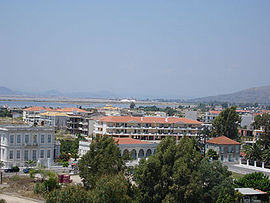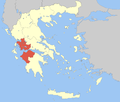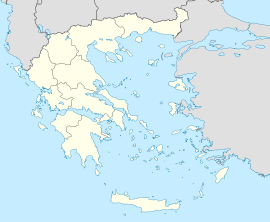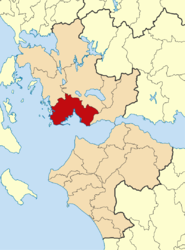- Missolonghi
-
Messolonghi
Missolonghi
Μεσολόγγι
View of the west part of the town.Location Coordinates 38°23′N 21°26′E / 38.383°N 21.433°ECoordinates: 38°23′N 21°26′E / 38.383°N 21.433°E Government Country: Greece Region: West Greece Regional unit: Aetolia-Acarnania Mayor: Panagiotis Katsoulis Population statistics (as of 2001) Municipality - Population: 35,431 - Area: 674.1 km2 (260 sq mi) - Density: 53 /km2 (136 /sq mi) Municipal unit - Population: 17,988 - Area: 280.2 km2 (108 sq mi) - Density: 64 /km2 (166 /sq mi) Community - Population: 12,225 Other Time zone: EET/EEST (UTC+2/3) Elevation (min-max): 0 - 9 m (0 - 30 ft) Postal: 302 00 Telephone: 26310 Auto: ΜΕ Website http://www.messolonghi.gr/ Missolonghi (Greek: Μεσολόγγι, Mesolóngi, older forms Mesolongi, Misolonghi, Mesolongion) is a town of 12,225 people (2001) in western Greece. The town is the capital of Aetolia-Acarnania and is also its third largest town. It is the seat of the municipality of Iera Poli Mesolongiou (Sacred City of Missolonghi). Missolonghi is linked to, although bypassed since the 1960s by, GR-5/E55. The road to Astakos is to the northwest and there is also access to GR-48 to the east. The town had a railway station on the line to Agrinio but this has been abandoned since the 1970s.
Contents
Geography
The town is located between the Acheloos and the Evinos rivers and has a port on the Gulf of Patras. It trades in fish, wine, and tobacco. The Arakynthos mountains lie to the northeast. The town is almost canalized but houses are within the gulf and the swamplands. The Messolonghi-Etoliko Lagoons complex lies to the west and is also a swampy area. In the ancient times, the land was part of the gulf.
Municipality
The municipality Missolonghi was formed at the 2011 local government reform by the merger of the following 3 former municipalities, that became municipal units:[1]
The municipal unit Missolonghi is subdivided into communities, including Evinochori.
History
Missolonghi was first mentioned by a Venetian called Paruta when he was describing the naval Battle of Lepanto near Nafpaktos. According to predominant historical opinion, its name came from the combination of two Italian words, MEZZO and LAGHI which means "in the middle of lakes" or MESSO and LAGHI (Messolaghi) which means "a place surrounded by lakes". Until 1700, Mesolonghi was under Venetian domination. Its inhabitants were mostly fishermen. They lived in cabins which were made of a kind of waterproof straw and reed and stood on stilts above sea water. These cabins or stilt-houses have always been called "pelades".
North-west of Missolonghi are the remains of Pleuron ('Asfakovouni'), a town mentioned in Homer's works. It participated in the Trojan expedition and was destroyed in 234 BC by Demetrius II Aetolicus. The new town, which was built on the remains of old Pleuron, was one of the most important towns in Aitolia. Its monumental fortification comprised thirty towers and seven gates. The remains of the theatre and an enormous water tank with four compartments still exist.
Greek War of Independence
Further information: Greek War of Independence, First Siege of Missolonghi, and Third Siege of Missolonghi The sortie of Missolonghi by Theodoros Vryzakis (1855).
The sortie of Missolonghi by Theodoros Vryzakis (1855).
During the Orlov Revolt in 1770 the fleet of Missolonghi was defeated and the town passed to the Ottomans. Missolonghi revolted on May 20, 1821 and was a major stronghold of the Greek rebels in the Greek War of Independence, being the seat of the Senate of Western Continental Greece. Its inhabitants successfully resisted a siege by Ottoman forces in 1822. The second siege started on April 15, 1825 by Reşid Mehmed Pasha whose army numbered 30,000 men and was later reinforced by another 10,000 men led by Ibrahim Pasha, son of Muhammad Ali Pasha of Egypt. After a year of relentless enemy attacks and facing starvation, the people of Missolonghi decided to leave the beleaguered city in the "Exodus of its Guards" (The Sortie) on the night of April 10, 1826. At the time, there were 10,500 people in Missolonghi, 3,500 of whom were armed. Very few people survived the Ottoman pincer movement after the betrayal of their plan.
Due to the heroic stance of the population and the subsequent massacre of its inhabitants by the Turkish-Egyptian forces, the town of Missolonghi received the honorary title of Hiera Polis (the Sacred City), unique among other Greek cities. The famous British poet and philhellene Lord Byron, who supported the Greek struggle for independence, died in Missolonghi in 1824. He is commemorated by a cenotaph containing his heart and a statue located in the town.
Modern Era
The town itself is very picturesque but also modern with functional, regular urban planning. Some very interesting buildings representative of traditional architecture can be seen here. People whose names were related to modern Greek history once lived in some of them. The mansion of the Trikoupis family, Palamas' House, Valvios Library, Christos and Sophia Moschandreou Gallery of Modern Art emphasize the fact that Missolonghi has always been a city of some wealth and refinement. In addition, the Centre of Culture and Art, Diexodos, which hosts cultural events and exhibitions as well as the Museum of History and Art is housed in a neo-classical building in Markos Botsaris Square and hosts a collection of paintings indicative of the struggle of Missolonghi, further boosting the city's cultural and artistic profile.
Today, the Entrance Gate remains intact and so does part of the fortification of the Free Besieged which was rebuilt by King Otto. Past the gate, there is the Garden of Heroes where several famous and some anonymous heroes who fought during the Heroic Sortie are buried. The Garden of Heroes is the equivalent of the Elysian Fields for modern Greece. Every year the Memorial Day for the Exodus is celebrated on Palm Sunday (the Sunday before Easter); the Greek State is represented by high-ranking officials and foreign countries by their ambassadors.
Landmarks
 The tomb of Markos Botsaris.
The tomb of Markos Botsaris.
- Museum of the History and the Art of the Holy City of Missolonghi, Website
Notable people
- The heart of Lord Byron is buried in Mesolonghi April 1824
- Epameinontas Deligeorgis (1829–1879), former Prime Minister of Greece
- John Lykoudis (1910–1980), major and medical doctor involved in the treatment of peptic ulcer disease
- Miltiadis Malakasis (1869–1943), poet
- Kostis Palamas (1859–1943), Greek poet, co-author of the Olympic Hymn
- Antonis Travlantonis (1895–1896), Greek educator, former director of Zosimaia School
- Charilaos Trikoupis (1832–1896), former Prime Minister of Greece
- Nikolaos Trikoupis, Greek general in the Greco-Turkish War (1919–1922)
- Spyridon Trikoupis (1788–1873), former Prime Minister of Greece, father of Charilaos Trikoupis
- Dimitrios Valvis (1814–1886), former Prime Minister of Greece
- Zinovios Valvis (1800–1872), former Prime Minister of Greece
- Sperantza Vrana (1926–2009), actress
Historical population
Year City Municipality 1981 11,375 - 1991 10,916 16,859 2001 12,225 17,988 Twin towns
See also
- Communities of Aetolia-Acarnania
References
- ^ Kallikratis law Greece Ministry of Interior (Greek)
External links
- Municipality of Missolonghi (Greek)
- Missolonghi's guide
- Information about Missolonghi (English)
 Chisholm, Hugh, ed (1911). "Missolonghi". Encyclopædia Britannica (11th ed.). Cambridge University Press.
Chisholm, Hugh, ed (1911). "Missolonghi". Encyclopædia Britannica (11th ed.). Cambridge University Press.- The Acheloos delta forms the Messolongi Lagoon
Northwest: Aitoliko North: Arakynthos Northeast: Makryneia West: Messolonghi Lagoon Iera Poli Messolongiou East: Chalkia South: Gulf of Patras Administrative division of the West Greece Region Area: 11,350 km² • Population : 740,506 (2001) • Capital: Patras Regional unit of Achaea Regional unit of Aetolia-AcarnaniaRegional unit of ElisAncient Olympia • Andravida–Kyllini • Andritsaina–Krestena • Ilida • Pineios • Pyrgos • Zacharo
Regional unit of Aetolia-AcarnaniaRegional unit of ElisAncient Olympia • Andravida–Kyllini • Andritsaina–Krestena • Ilida • Pineios • Pyrgos • ZacharoRegional governor: Apostolos Katsifaras (el) • Website: www.pde.gov.gr  Prefectural Capitals of GreeceAgios Nikolaos • Alexandroupoli • Amfissa • Argostoli • Arta • Athens • Chalcis • Chania • Chios • Corfu • Corinth • Drama • Edessa • Eleusina • Ermoupoli • Florina • Grevena • Heraklion • Igoumenitsa • Ioannina • Kalamata • Karditsa • Karpenisi • Kastoria • Katerini • Kavala • Kilkis • Komotini • Kozani • Lamia • Larissa • Lefkada • Livadeia • Missolonghi • Mytilene • Nafplion • Pallini • Patras • Piraeus • Polygyros • Preveza • Pyrgos • Rethymno • Rhodes • Serres • Sparta • Thessaloniki • Trikala • Tripoli • Vathy • Veria • Volos • Xanthi • ZakynthosCategories:
Prefectural Capitals of GreeceAgios Nikolaos • Alexandroupoli • Amfissa • Argostoli • Arta • Athens • Chalcis • Chania • Chios • Corfu • Corinth • Drama • Edessa • Eleusina • Ermoupoli • Florina • Grevena • Heraklion • Igoumenitsa • Ioannina • Kalamata • Karditsa • Karpenisi • Kastoria • Katerini • Kavala • Kilkis • Komotini • Kozani • Lamia • Larissa • Lefkada • Livadeia • Missolonghi • Mytilene • Nafplion • Pallini • Patras • Piraeus • Polygyros • Preveza • Pyrgos • Rethymno • Rhodes • Serres • Sparta • Thessaloniki • Trikala • Tripoli • Vathy • Veria • Volos • Xanthi • ZakynthosCategories:- Populated places in Aetolia-Acarnania
- Mediterranean port cities and towns in Greece
- Municipalities of West Greece
- Greek prefectural capitals
- Holy cities
Wikimedia Foundation. 2010.





